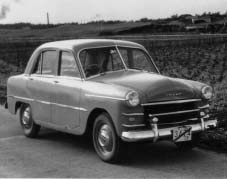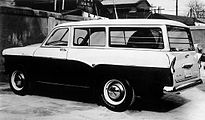|
Prince Sedan
The Prince Sedan was a Japanese compact executive car made from 1952 until 1957 by the Tama Motor Company (renamed the Prince Motor Company in November 1952), which was one of the successors of the Tachikawa Aircraft Company. It was replaced by the first generation Prince Skyline ALSI in 1957.[2] The Prince Sedan AISH had live axles in front and the back.[2] In March 1956, the Prince Sedan Special AMSH was added to the line-up. It had a double wishbone suspension in front.[2] BackgroundThe Tama Electric Car Company was producing several kinds of electric vehicles. Before the Korean War, the supply of gasoline was controlled by the GHQ and was expensive. In June 1950, the Korean War broke out. The price of batteries became extremely high (approximately ten times). On the other hand, the price of gasoline became cheaper. Tama Electric Car could not continue to produce electric vehicles.[2] In September 1950, they decided to produce new gasoline vehicles instead of electric vehicles. In November 1950, they officially ordered the Fuji Precision Industries, one of the successors of disbanded Nakajima Aircraft Company, to design and produce a new gasoline engine for Tama.[2] Tama finally stopped building electric vehicles in September 1951. In the next month, Fuji Precision completed the new gasoline engine named FG4A. This engine was based on the engine of the Peugeot 202 which was owned by Shojiro Ishibashi, the Bridgestone founder and the owner of the Tama Motors and the Fuji Precision.[2] This engine (later renamed as G-1) was improved and modified gradually and was used until 1968 for the basic version of Prince Skyline S50, and was shared with the Subaru 1500 the first Subaru manufactured. (The upper version S57 used the new G15 SOHC engine in 1967 and 1968.)[2] Around ten people belonged to Tama's development team headed by the design manager Jiro Tanaka. His assistant manager Takuya Himura, who would become the direct boss of Shinichiro Sakurai in October 1952, was in charge of the development of the Prince Sedan and other vehicles.[1][3] AISH-1
In 1952 the AISH-1 was introduced. An evolution of the previous Tama Senior sedan, the front end resembled Russian cars of the era and the side had a European look. The engine was the new 45 hp (46 PS; 34 kW) 1.5L FG4A-10, an enlarged and modified version of the Peugeot 202 engine. There was also a truck version based on the AISH-1, the AFTF-1, which was also available in double cab and van versions. The AISH-1 was in production until June 1953, when it was replaced by the AISH-2. AISH-2
The AISH-2 was released in 1953 and was in production until November 1954. Although the styling was nearly identical to the previous model, the AISH-2 was both wider and slightly taller, thanks to changes in legislature in Japan in late 1952 that allowed the production of slightly larger passenger cars. The only other change was to the wheels, which were changed from 16 inches on the AISH-1 to more modern 15-inch ones. The engine and transmission were carried over unchanged from the previous model.  AISH-3
The AISH-3 was released in November 1954. The changes to the AISH-3 were cosmetic, with a new grille design as well as a new side strip design. Engine and transmission remained the same. The AISH-3 was short-lived as it was replaced by the AISH-4 after only two months in production. AISH-4
The AISH-4 was released in February 1955 and was identical to the AISH-3 except for the engine, which was modified with a new cylinder head design that raised compression, increasing power to 52 hp (53 PS; 39 kW) and top speed to 115 km/h (71 mph). AISH-5
The AISH-5 was released in October 1955. The engine and transmission remained the same, but the exterior was redesigned. The grille was changed and now featured a "V" cast in the middle bar. The side strips were redesigned with a 45 degree bend in the front portion. Two-tone paint, a popular option, was introduced with the AISH-5. In addition to the Sedan Standard there was also a Deluxe model, featuring extra equipment such as a radio, white sidewall tires, and an exterior sun visor.[4] In 1955 two commercial vehicles based on the AISH-5 were released: the AIPC-1 double cab pickup and the AIVE-1 delivery van. In March 1956 the AMSH-1 was released. This model was nearly identical to the AISH-5 except for the double wishbone independent front suspension which provided improved ride quality. AISH-6
The AISH-6, the final model in the AISH series, was released in October 1956. The grille was the same as the previous model, but the side strips were changed, now running horizontally the length of the car, except for a small V-shaped dip near the back of the rear doors. Two-tone paint remained available, but the colors were reversed: the dominant color was on the top section of the car and the contrast section on the bottom, opposite that of the previous model. Engine power increased again to 60 hp (61 PS; 45 kW) thanks to higher compression as improved quality fuel was becoming available in Japan. The commercial variants were upgraded as well and were redesignated AIPC-2 and AIVE-2. An upmarket model with independent front suspension, the AMSH-2, was also available. History



See alsoReferences
External linksWikimedia Commons has media related to Prince Sedan. |
||||||||||||||||||||||||||||||||||||||||||||||||||||||||||||||||||||||||||||||||||||||||||||||||||||||||||||||||||||||||||||||||||||||||||||||||||||||||||||||||||||||||||||||||||||||||||||||||




